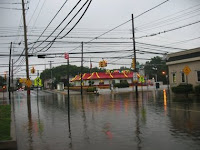1. Three snaps up for the comprehensive emergency response plan that was put into place to alert the citizens along the East Coast.
2. Mayor Bloomberg did an excellent job of protecting NYC.
3. Cheers to the FDNY for evacuating 63 people in Bulls Head, Staten Island in the midst of the storm.
4. Cheers to the rescue teams in the city and neighboring counties.
5. Governor Cuomo did an excellent job in allocating emergency support services for the state of New York.
6. Governor Christie did an excellent job of warning the residents of the coastal areas of New Jersey and the state of New Jersey.
7. So far, as of Sunday, August 29th, there have been a limited number of fatalities.
The Bad:
1. There are significant power outages after Hurricane Irene. Here are the estimations:
a. New York City - 61,000
b. Long Island - 469,000
c. New Jersey - 708,000
d. Connecticut - 620,000
e. Westchester - 40,000
2. There are many fallen trees. The downed trees are next to power lines.3. There is and will be significant flooding next to the rivers and tributaries that feed into New York State.
4. There is a significant amount of debris that has to be cleaned up. Road crews will have to deal with the sinkholes throughout the city.

We are still missing the overall picture.
The emergency management system worked.
Hurricane Irene, by the time it reached the tri-state area, was a 70 to 100 mile wide category 1 system.
There were high winds, flooding, and debris damage. Disgusting stuff floats in the water as all manner of things come up from the sewers. The transportation system was shut down and there will be significant damage to subway stations and cars in areas that are prone to flooding. We as a nation need to be forward thinking about what infrastructure can be put into place to make sure there is a major reduction of flooding that continually happens whenever any weather event occurs that involves water.
We as a nation need a system of retaining walls throughout all of the rivers and tributaries. Do we really think we can afford to have water crashing up and over the retaining walls that eventually affect highways, which are the main thoroughfares needed if we had to do mayor evacuations?
As neighborhoods grow we need the infrastructure to support the development of more residences, malls, and offices. How do we deal with an electrical power supply that is above ground and therefore subject to fallen trees and floods from weather systems like Hurricane Irene?
It requires more than emergency response plans on a city or state level. It requires engaging in conversations and plans on a national level that generates methods for improving the infrastructure - Now!













